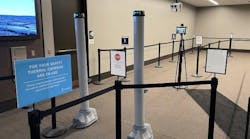NEW YORK -- Government scientists from Washington state who want to find out how fast and far a chemical attack could move through a city will release colorless, harmless gases in subways, an office building and some of Manhattan's most crowded streets to see which way the wind blows them.
Ultimately scientists hope they can produce a computerized model of air flow patterns that could help authorities decide where to evacuate people and in which direction after a bioterrorist attack.
"You can use those models to say, `What if something happened here?'" said Jerry Allwine, an engineer with the Pacific Northwest National Laboratory in Richland, Wash.
Allwine is overseeing the Urban Dispersion Project, which started five years ago with pilot programs in Salt Lake City and Oklahoma City, and came to New York City in March, tracking the path of nontoxic, odorless gases through well-traveled sections of midtown Manhattan.
While the March studies concentrated on outdoor air patterns, this month's tests will include a release inside a midtown office building, the subways and outside major landmarks to track how air moves in and out of structures.
"We want to understand where the winds blow and where particles are taken," said Tom Keiss, who manages the program for the Department of Homeland Security.
On six days over the next three weeks, depending on the weather, 180 blue plastic "tracer" boxes will track the path of gases released at eight different locations. The gases will be released at two locations near Rockefeller Center, one near Times Square and one on a subway platform at 50th Street and Broadway, serving the 1 and 9 lines. A half dozen white vans will also be traveling the city collecting air samples.
The tracer boxes will be fastened to light poles and rooftops, and eight of the boxes will be stationed for six hours at other subway platforms throughout the city, watched by volunteer interns with security badges, Allwine said. About 50 interns will be taking air samples from smaller versions of the boxes they can clip to their belts. Some will walk the area covered by the study -- 35th to 61st streets, and Tenth to Third avenues -- while still will ride the subways to track the path of gases released above ground into the system.
Midtown Manhattan is ideal to track urban air patterns because of the street canyons between its tall buildings, Allwine said. The March study taught the scientists that prevailing wind patterns are best gauged from rooftops, because wind tunnels created by the buildings can move gases at street level in every direction, he said.
"You can't depend at all on the street level wind movements to decide where to evacuate," he said.
The scientists will conduct a third set of tests in New York next March, and plan to complete their research by 2007.
Copyright ©2005 The Associated Press

